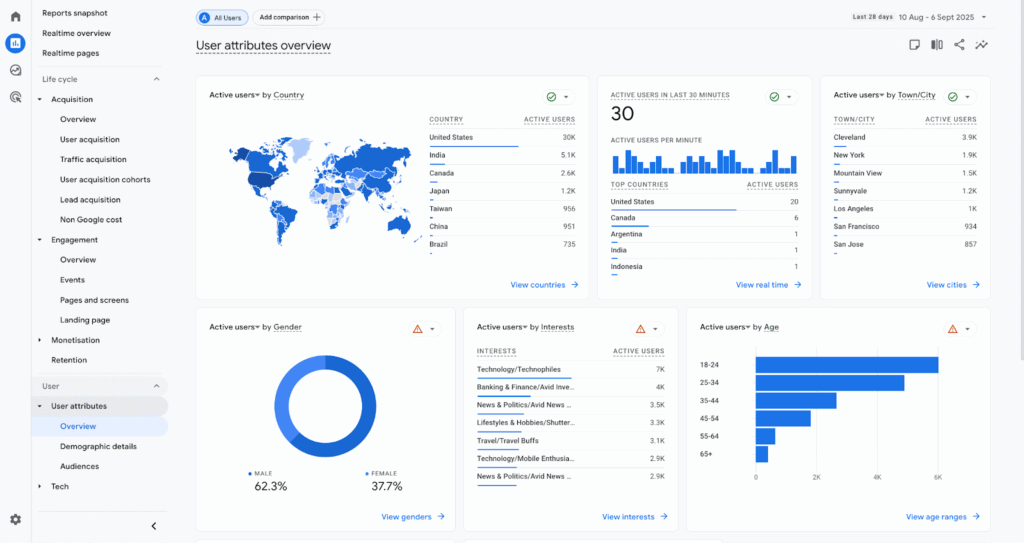Analyzing User Demographics for Targeted SEO Strategies
Key Takeaways
- Analyzing user demographics helps align your SEO strategy with your ideal audience, attracting qualified traffic and improving engagement.
- User demographic analysis prevents creating content that attracts the wrong readers and ensures your SEO efforts are reaching the right audience.
- Adjusting your SEO strategy based on demographic insights can involve refining keyword targets, adjusting content topics, and tailoring messaging for better results.
Driving traffic to your site is one thing. Making sure it’s the right traffic is another.
Small to midsize businesses often find themselves in a tricky spot: they may have a clear picture of their ideal customer, but they don’t always know if the people landing on their site actually fit that profile.
That’s why analyzing user demographics is so valuable. By examining traits like age, location, and interests, you can see how closely your current visitors align with your ideal audience. If there’s a gap, you can adjust your SEO strategy to attract the people who matter most.
In this post, we’ll show you where to find user demographic data, how to compare that data to your ideal customer profile, and how to apply those insights to sharpen your SEO targeting.
Why User Demographics Matter in SEO
SEO is about more than getting clicks. It’s about attracting ideal customers to your site.
If you don’t check whether your current visitors match that profile, you can end up creating content that attracts the wrong readers, optimizing for keywords that aren’t relevant, or building visibility in markets that don’t buy from you.
Demographic analysis helps you catch those mismatches early. It tells you whether your SEO is reaching the right audience or drifting off course.
Once you know where the gaps are, you can adjust. That might mean refining your keyword targets, shifting your content topics, or tailoring your messaging so your strategy aligns more closely with the customers you want to reach.
Remember, when your SEO is aligned with the right audience, you’ll attract more qualified traffic, see stronger engagement, and get better results from the same amount of effort.
Further reading: User Personas for SEO: How They Can Lead to More Growth
Where to Find User Demographic Data
To see how well your current visitors match your ideal customer profile, start with tools that show you who’s already interacting with your business online.
Google Analytics 4 (GA4)
GA4 gives you demographic reports on the people visiting your site. You can view breakdowns by age, gender, location, and even interests.

For example, you might discover that most of your visitors are in the 18–24 age group when your ideal customers are 35–44. That kind of gap tells you your current SEO strategy may be attracting the wrong audience.
Social Media Insights
If you have active social channels, Facebook, Instagram, and LinkedIn all provide data on the demographics of your followers.
While this data reflects social engagement rather than website visits, it still shows who is connecting with your brand online. Comparing these insights with your site data can highlight trends—such as a younger audience engaging on social but not yet finding your site through search.
How to Compare User Data to Your Ideal Customer Profile
Collecting user data is only useful if you measure it against the right benchmark. That benchmark is your ideal customer profile: the age, location, interests, and other traits of the people most likely to buy from you.
Start by placing your customer profile alongside the demographic data from GA4 or social platforms. This makes it easier to see where your current visitors line up with your ideal customers and where they don’t. For example, you might find that most of your visitors fall into the same age ranges and regions you’re targeting, which is a good sign your SEO is reaching the right audience.
If there are mismatches, look closely at what they really mean. Some data points, like age or location, carry more weight because they directly influence buying potential. A local service business, for instance, can’t benefit much from visitors in other states. And if your ideal buyers are in their 40s, a surge of visitors aged 18–24 is unlikely to generate sales. Other signals, like “interests,” are less reliable because GA4’s categories may not align with how you define customer needs. Don’t assume every difference means you’re attracting the wrong people.
It’s also normal for some of your traffic to fall outside your ideal profile. No website ever attracts 100% perfect visitors. What matters is that your core audience makes up a meaningful share of your traffic—often at least half, depending on your goals and market size. If only a small slice of your traffic matches your target customers, your SEO may be missing the mark. But if the majority of your visitors look like your ideal buyers, occasional outliers aren’t a problem.
Further reading: Creating Buyer Personas for Effective Marketing
What to Do If Your Users Don’t Match Your Ideal Customers
If your user demographics and ideal customer profile don’t line up, it’s time to make some adjustments.
Here are some tips for reorienting your SEO to your ideal buyers:
1. Refine Your Target Keywords
A demographic mismatch often means you’re ranking for keywords that your target customers aren’t searching for.
To fix this, rebuild your keyword list with your ideal customers in mind:
- Start with competitor analysis: Identify websites that target the same customer profile as you, and use tools like Semrush or Ahrefs to uncover which keywords they rank for. This helps you see what terms will attract the right type of visitor.
- Use qualifiers: If location, life stage, or specific needs are central to who you serve, make sure your keyword list includes long-tail variations that capture those traits. For example, “family dentist in Chicago” would bring you closer to your ideal customer than the broad term “dentist.”
- Mine customer feedback for search terms: Pay attention to the exact words customers use in reviews, sales calls, or support emails. These phrases might already show up in keyword tools, but hearing them repeatedly from customers confirms they matter.
2. Shape Content Topics Around Customer Priorities
Once you’ve rebuilt your keyword list, the next step is to look for common themes across those terms. These patterns reveal some of your ideal customers’ biggest pain points and priorities.
For example, if you see repeated searches for “pediatric dentist,” “kids’ braces,” and “child-friendly dental office,” it’s a strong sign your audience cares about dental services designed for children.
Use these recurring themes to guide your content plan. Group related keywords together into clusters so you can cover each topic comprehensively, ensuring your SEO strategy is built around the issues your target customers care about most.
3. Tailor Content Style and Format
Knowing what topics to cover is only half the job. You also need to present that content in a way that resonates with your ideal customers.
Review the top-ranking pages for each of your target keywords to see what formats perform best. If search results are dominated by video tutorials, your target customers likely value visual instruction. If long-form guides consistently rank, your audience may prefer detailed, written explanations.
It’s also worth considering local or cultural context when relevant. For example, if your ideal customers are concentrated in a specific region, weaving in place-specific examples or references can make your content feel more relevant.
By aligning your content style and format with both your audience’s demographics and the standards set by top-performing pages, you increase the odds of attracting and converting the right visitors.
4. Validate Progress Over Time
After you’ve refined your keywords, shaped your topics, and tailored your content style, you need to confirm that those changes are attracting more of your ideal customers.
Revisit your GA4 demographic reports regularly to see if your visitor profile is shifting closer to your target audience. Are you seeing more traffic from the right age groups, locations, or interest categories? Compare these changes to engagement metrics like engagement rate, average engagement time, and conversions to make sure the right audience isn’t just arriving but also interacting with your site.
Remember, no website will ever attract only ideal customers. The goal is to increase the share of visitors who match your target profile. If that proportion grows over time—and you see engagement and conversions improve alongside it—you’ll know your SEO adjustments are paying off.
Final Thoughts
Analyzing user demographics isn’t about chasing numbers. It’s about making sure the visitors finding your site look like the customers you most want to serve.
By comparing demographic data to your ideal customer profile, you can spot when your SEO is on track and when it needs a course correction.
The steps are straightforward: refine your keyword list, focus on the topics that matter most, tailor your content style, and check back over time to confirm you’re attracting more of the right audience. Do this consistently, and your SEO will deliver not just more traffic, but better traffic—the kind that converts into customers.
